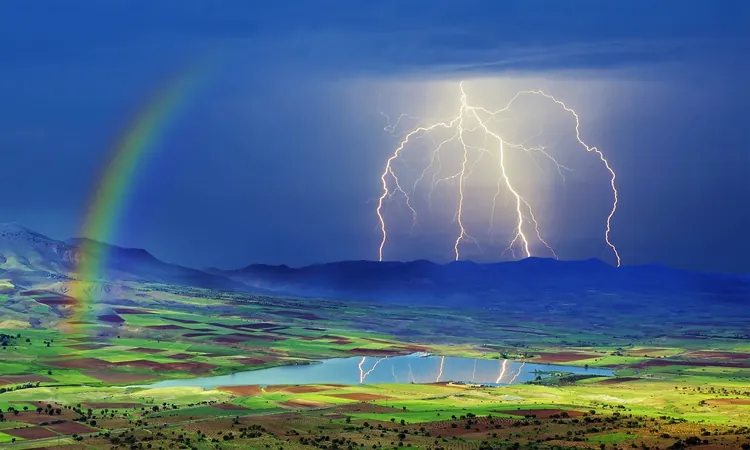
How One Million Years of Rain Changed the Course of Earth's History and Launched the Age of Dinosaurs
2024-11-15
Author: Ying
Picture a world 233 million years ago, where all continents were united in a mega landmass known as Pangea, and a sea of transformation was about to unfold. This was the scenario during the Carnian Pluvial Episode (CPE), a remarkable period marked by a million years of unprecedented rainfall that dramatically reshaped life on Earth.
A groundbreaking study led by an international team, including Dr. Jacopo Dal Corso from China University of Geosciences and Professor Mike Benton from the University of Bristol, has revealed critical insights about this monumental extinction event that cleared the way for dinosaurs to reign supreme.
The Carnian Pluvial Episode Unveiled
In the Late Triassic era, Earth's land consisted of the supercontinent Pangea surrounded by the expansive Panthalassa Ocean. The interior of this colossal landmass was predominantly dry, with rain sporadically gracing the coastal areas. However, the landscape of life underwent a severe change when geologists discovered a striking layer of dark gray rock in Austria’s Northern Limestone Alps back in the 1970s. This discovery hinted at shifting wet conditions interspersed with arid phases, signaling a global climatic upheaval — the Carnian Pluvial Episode.
The catalyst for this transformation was none other than monumental volcanic eruptions originating from what is now the Wrangellia Province of Alaska and British Columbia. These explosions unleashed enormous quantities of carbon dioxide into the atmosphere, triggering a remarkable spike in greenhouse gases.
Dr. Dal Corso's research emphasizes the massive scale of these eruptions: “They were so immense that they triggered significant global warming and led to soaring levels of greenhouse gases, ultimately transforming our planet's climate.
Mass Extinction and the Rise of New Species
As these greenhouse gases accumulated, global temperatures rose by 5 to 7 degrees Fahrenheit, dramatically increasing evaporation and rainfall across the planet. The environmental turbulence wrought havoc on existing ecosystems, resulting in a significant mass extinction event as many species struggled to adapt to rapid changes.
However, in the aftermath of this chaos, nature started to refurbish itself. "The new flora probably provided slim pickings for the surviving herbivorous reptiles," Professor Benton explains. While dinosaurs had been around for approximately 20 million years prior, they remained relatively insignificant until the CPE created new ecological niches for them to occupy.
Dinosaurs Rise: The New Monarchs of Earth
As conditions transitioned back to a drier climate, dinosaurs began to flourish, alongside the emergence of the first turtles, crocodiles, lizards, and some of the earliest mammals. The proliferation of conifer forests provided a variety of new habitats, allowing these species to diversify and thrive.
Moreover, the oceans underwent dramatic changes as well. The CPE signified the dawn of modern coral reefs and the emergence of diverse plankton groups, indicating a profound shift in ocean chemistry and food chains—far-reaching consequences for marine ecosystems that resonate even today.
A New Chapter in Earth's History: Recognizing a Sixth Mass Extinction
Historically, scientists have cataloged five major mass extinctions over the past half-billion years, but the CPE has emerged as another pivotal event deserving attention. "We have identified another significant extinction that played a critical role in resetting life both on land and in oceans," Dr. Dal Corso elaborates.
Lessons for Today: How Past Events Inform Our Future
The insights gleaned from the Carnian Pluvial Episode serve as a stark reminder of how volcanic eruptions and climatic upheavals can redefine life on Earth. Today, as human activities elevate greenhouse gas levels, the lessons of the CPE resonate widely. How will current ecosystems adapt — or struggle — amid rapid environmental changes?
Dr. Dal Corso's observations shed light on the potential impacts of human-induced climate shifts: “Understanding these historical events helps us prepare for our current challenges.
The CPE not only marks the surge of dinosaurs but also illustrates Earth’s resilience and capacity for rebirth in the face of catastrophic events. Each ongoing exploration into our planet's past contributes significantly to how we perceive the future of life on Earth, revealing the striking ability of nature to recover and evolve.
This significant study was published in the prestigious journal *Proceedings of the National Academy of Sciences (PNAS)*, highlighting the importance of interdisciplinary collaboration in deciphering Earth's intricate history. As we dive deeper into these discoveries, we can learn valuable lessons from our planet’s resilient journey.
Stay tuned for more intriguing insights into our planet's ancient past!


 Brasil (PT)
Brasil (PT)
 Canada (EN)
Canada (EN)
 Chile (ES)
Chile (ES)
 España (ES)
España (ES)
 France (FR)
France (FR)
 Hong Kong (EN)
Hong Kong (EN)
 Italia (IT)
Italia (IT)
 日本 (JA)
日本 (JA)
 Magyarország (HU)
Magyarország (HU)
 Norge (NO)
Norge (NO)
 Polska (PL)
Polska (PL)
 Schweiz (DE)
Schweiz (DE)
 Singapore (EN)
Singapore (EN)
 Sverige (SV)
Sverige (SV)
 Suomi (FI)
Suomi (FI)
 Türkiye (TR)
Türkiye (TR)